#is still weird to me that Jill is now a city player
Text
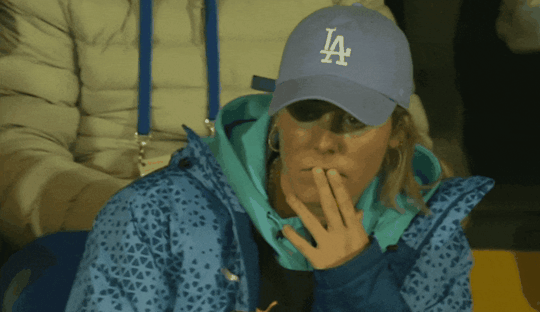

Jill Roord
#the quality is terrible but is the only way i could make it work#is still weird to me that Jill is now a city player#jill roord#manchester city women#man city women#woso#gifset
279 notes
·
View notes
Text
The ones that suffer the most
I wanted to talk about this for a long time.
I’m a Resident evil addicted, I finished almost every RE game released and I must say that Capcom made some poor choices regarding Jill and Chris, they are EASILY the most mistreated characters in RE Franchise.
But let’s explain why is that:

Jill and Chris are survivors, they had to survive in a mansion with a lot of puzzles and zombies, while looking for items that could help them to progress and find a way to reach Brad.
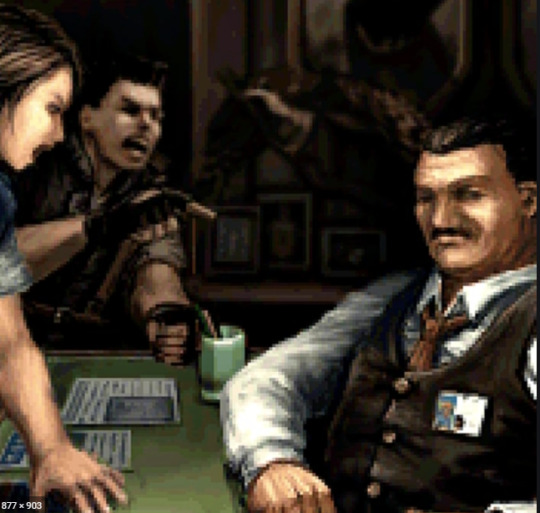
When they arrive at STARS Office, they are revolted that Umbrella did all that under their noses and innocents were dying because of that and they explained EVERYTHING in a report - but Irons made that go away.
In the ORIGINAL RE3 we had this special file (Jill’s Diary)
August 7th
Two weeks have passed since that day. My wounds have been healed, but I just can't forget it. For most people, it's history now. But for me, whenever I close my eyes, it all comes back clearly. Zombies eating people's flesh and the screams of my teammates dying. No, the wounds in my heart are not healed yet...
August 13th
Chris has been causing a lot of trouble recently. What's with him? He seldom talks to the other police members and is constantly irritated. The other day, he punched Elran of the Boy's Crime department just for accidentally splashing Chris's face with coffee. I immediately stopped Chris, but when he saw me he just gave me a wink and walked away. I wonder what happened to him...
August 15th
Midnight. Chris, who has been on a leave of absence for a "vacation," called me so I visited his apartment. As soon as I walked into his room, he showed me a couple of pieces of paper. They were part of a virus research report entitled as simply as "G". Then Chris told me that, "The nightmare still continues." He went on to say that, "It's not over yet." Ever since that day, he has been fighting all by himself without rest, without even telling me.
August 24th
Chris left the town today to go to Europe. Barry told me that he would send his family to Canada and then he would follow Chris. I decided to remain in Raccoon City for a while because I know that the research facility in this city will be very important to this entire case. In a month or so, I'll be joining with them somewhere in Europe. That's when my real battle begins...
For some weird reason this file isn’t available in RE3 Remake.
But ok, here we see that Chris was doing some investigation - in the RE2RMK you could see this letter that Chris left in a way that normal people wouldn't understand - the only thing that Claire says is that “doesnt look like him” but how normies would understand what Chris is like is he is not well represented in media ??????????????????
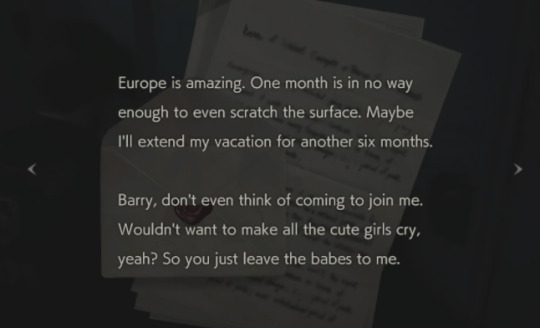
And Jill had all the detective work in her wall.
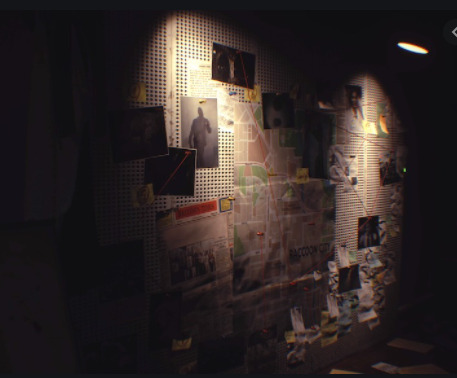
So far so good - we understand the basics about them - they are Special police force, the elite, they had a traumatic experience and they survived to tell the story.
Some problems until now:
Jill had a MAJOR personality change in RE3 RMK- I honestly like most of that, she is a badass in the originals and she is a badass in the rmk but I still dislike the fact that she swears all the time (specially because in RE1, RE Rev, RE5 she doesn't do that)
We can tell a lot about her personality just looking at her room, but I still miss some stuff (I had expectations - so this is not a real problem. but still) like a Vinyl player (since she is probably into classical music), some letters from her father so new players can understand her origin and why is she so good in lockpicking and more about her dog (she had a pic in the original that could’ve been her boyfriend but it was replaced by a dog in RE2 rmk but in RE3 Rmk there in no dog)
Okay - after you finish the game the only thing we see is this:

In my opinion this is Chris since he is always associated with Green colors while Jill is associated with blue.
So my speculation here is that she found him while in the original we had this:

This is not a major chance but still is important (lore of course - duh) but the problem here is that while Jill is looking for him - Code Veronica is happening.
So I can only assume two things, they did not show him because they DON’T HAVE A FACE FOR HIM or I am wrong and that is Jill, but if that is Jill so why there is no decent epilogue like the original ?
Okay, now we are arriving in the real trouble area
I will do RE5 first and the Wii and Rev1 (even tho those two comes first in the lore)
RESIDENT EVIL 5
So before the game was release we had some propaganda, including this:

So have in mind that Jill was dead, I thought that she died and RE5 would explain that shit.
But in the beginning we see that Chris is looking for her and have in mind that Chris HAD A MAJOR CHANCE IN HIS APPEARANCE, and I’m not talking about his muscles.

I will not address Chris in CV since he was good in that game but I the team that made CV also made the original, it had CONSISTENCE.
Here we have Chris, he’s THE classical american soldier protagonist from Hollywood in the 80′s/90′s and he had some omage to TOPGUN

He also shares some traits with his sister
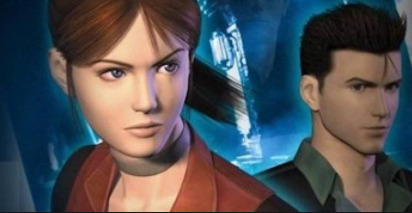
A major trait here is that HE HAS BLUE EYES, typical good looking soldier from US.
and now let’s have a look at Chris in RE5...

Yeah... I still hate this face even tho I love his Character in this game, this ugly a** monkey looking mf and he had a lot of steroids
So we have some lore to him in RE5, Jill and Chris went to a mansion looking for Spencer (one of the fathers of Umbrella and the one that was behind project Wesker, he wanted to do this Virus so he could live forever, so RE has a good lore, it’s not just about zombies) but when they found him, he was dead and Wesker was by his side, in a fight Jill sacrificed herself to save Chris’s life.
Chris started doing mission after mission because her body was never found, and he made a name for himself, he became a ‘legend’ inside BSAA and you can see that in the beginning of RE5.
The reason behind the muscles was probably to fight Wesker mano to mano but still is not well made, it really felt weird playing for the first time.
So now we have a problem here, there is thing that you use in a narrative that is to make someone strong af powerless, and they did that to Jill. (a good example of this is in TWD- Ricky is a fucking legend and Negan made him powerless in the face of a event)
Jill was used in a Boss fight and that is it... She is not in the game as a character, she is being manipulated and her whole design was changed, she looks like Nina from Tekken. WTF. - BTW, the fact that Wesker had mind control over her created 1000 fics of sex

So that is it, my main problem here isnt Jill itself, but it’s the fact that they used her character as a boss even tho she is the heroine, she never appears in RE lore again until some guy inside Capcom said “Well people are asking about Jill so let’s place a file in Rev2 saying that she is in rehab”
The only time that she appears again is in a 3DS NINTENDO ONLY game, it felt that Capcom simply don’t care about her character.
By the way Revelations 1 is a great game and was adaptable some years later for PC and consoles
But you think that this is bad, wait until we arrive at RESIDENT EVIL 6
When I learned that Jill was not in RE6 I was mad... But after I played that game I said “thank you God” that game was bad, transformers kind of bad, it had bad writing, the lore was all over the place and Chris was the one that suffered the most in this game.
He was responsible for the death of an entire squad, suffered amnesia and people still wanted him in the command

THEY MADE HIM AN ALCOHOLIC
The golden boy of BSAA reduced to THIS.
By the way, the director said that HE WANTED TO KILL CHRIS IN THIS GAME to SUBVERT EXPECTATIONS - so if you liked Piers now that he died only because of that.
So now let’s analyse what we know:
The first 2 main characters are not well represented in media until RE6, they don’t know how to re introduce Jill in the games and Chris was reduced to a normal guy at a Russian bar;
But it gets worse...
Capcom LOVE Leon, we know that. he is always the hero, he is the protagonist in almost every movie and he is always the cool guy so when he get’s a new model, he looks like this:

But When Chris get’s a new face he look like this:

WHO DAFUQ ARE U, no offense to the model but he has NEGATIVE JAW LINE.
And still he doesn't look like Claire’s brother, there is no blue/green eyes and he looks younger that he was in 6 (and 6 still uses that ugly character model)
But let’s go in the lore- we HAVE 0 info on Jill in RE6 / RE7 and no sight of her in RE8
And speaking of which, they tried to make Chris the bad guy in the trailer so when we play we see “Ohhhh he was not the bad guy, that happened and that is why he did that”
But still...
If they are going to do that to his character don’t use this character, shit ! Do something with that Wesker’s son that made 0 sense in RE6 but leave Chris out of this - it really feels that they simply don’t know how to treat him right
And you may think that I may be complaining a lot because of his appearance
But this is him in RE8
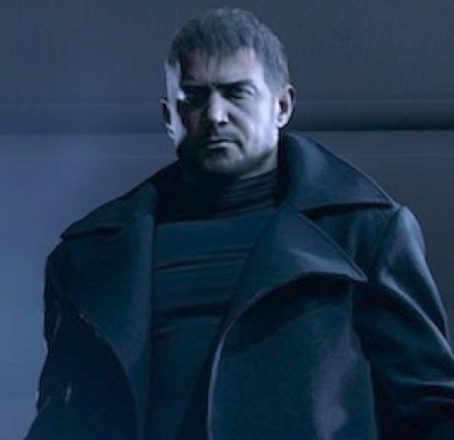
(to me this is some random dude from Russia)
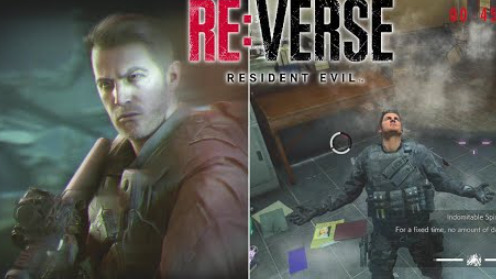
And this is him in RE:Verse (that is going to be release TOGETHER)
So this tells me that they have 0 clue of how to handle his looks
Jill got RE3Rmk but it felt like a cheap game compared to RE2Rmk where the original RE3 was SO MUCH BETTER
And this is bad because there are so many new fans joining the fandom only to see 2 great characters suffering from poor director’s choices.
I’m sorry about this rant, if you like Chris face and looks its okay, really, but dont tell me that Chris from 5/6/8 is the same from 1/CV and if you think im wrong about Jill its fine, but she is an amazing character that could have so much more impact in RE universe (I mean, she never even appeared in a RE movie - animations)
But it’s sad to see so many characters that receive good representation in media and good games/lore while Jill get’s almost none and Chris is handled like random face guy.
I was going to talk a little bit more about Rev 1 and RE Umbrella Chronicles but there is no need since Im mad right now and it seems that Capcom has 0 interest in making Code Veronica and Umbrella’s fall after that since their fav boy Leon need a rmk in RE4 even tho RE4 is not that old.
Bonus:

Fun fact: Chris served in the Air force, so yeah, to me even Tom Cruise looks more like Chris than Chris from the games
#resident evil#resident#evil#chris#redfield#Jill#valentine#resident evil 8#rant#capcom#Claire Redfield#leon scott kennedy#visual#valenfield#topgun#capcom dont know how to handle good characters#directors wanting to kill chris#now he could be a werewolf#for fucks sake#at least#ethan#is being handled better#than they are#good job capcom#very nice indeed#now im going to watch top gun#just for fun#reverse#re verse#resident evil 3
123 notes
·
View notes
Note
can you maybe talk about Va-11 Hall-A? you talking about it a little made me remember i had to play it so i did and I liked it a lot and would like to hear your opinions as I respect you
its only been a few days but i think ive reached all the conclusions about the game i need to. i think VA-11 HALL-A is a really good game and a great visual novel yes its a visual novel dont @ me im right. actually i think its funny the game tells you to curl up with a blanket and snacks like its gunna be a chill relaxing experience because like tonally speaking its kind of not. theres some heavy shit in the game especially near the end and its not the kind of light chatting simulator you might think it is. not saying i think its a stressful game or anything but i alwys thought that was funny.
anyway heres my real thoughts. im gunna put it under a readmore for spoilers after a certain point
oh also make sure you play the prologue chapter and the anna demo. those are extremely important despite being hidden behind a nondescript menu icon that the game makes no effort to tell you about. thats genuinely my only complaint about the game
there’s a quote by mike pondsmith, the creator of the cyberpunk ttrpg about how cyberpunk “...can not be about saving the world. You’re saving yourself or your community. The stakes have to be something that involves the player. You can’t just say, ‘The world is craptastic and you can’t do anything about it.’ No. You don’t have to save the world, but you need to be able to save your mother or the apartment you and your friends live in.”
and i think that ideology was, intentionally or otherwise, probably otherwise because im pretty sure pondsmith gave this quote a few years after VA-11 HALL-A came out, very clearly captured in this story. Jill and her friends live in this terrible shitty city in a terrible shitty world but thats just the setting yknow. glitch city is a backdrop to tell a series of small scale personal stories, not about “surviving in a hellish dystopian” but just...living in the real world. thats just real life for these people you know. every story told in the game is very personal. nobody is blowing up corporate buildings or igniting a revolution its just like, dorothy reconciling her anxieties about being close to her mother, alma’s family troubles, stella and sei’s mutuals traumas and their close relationship, Jill’s grappling with her own life choices. its nothing crazy its very pedestrian and lowkey, its not exactly something you’d expect from a game with CYBERPUNK stamped on the subtitle but it fits the genre extremely well.
if nothing else VA-11 HALL-A is extremely well grounded in the reality its set in, everything feels lived in and real, like glitch city is a real place you could go to or something. all those newspaper articles about big events right next to articles about some lilim idol or reruns of a nostalgic anime and the danger/u/ posts about weird conspiracies and arguments about stupid weeb shit it just creates a wholesale sense of realism. i once saw someone complain that in persona 5, you only ever hear other students and people in the streets of tokyo talk about whatever is currently happening in the story and at the time i dismissed it as nitpicking but after VA-11 HALL-A i understand that a little better, it creates a game world that only revolves around the player’s actions and story as opposed to a world that keeps turning on its own that your character just so happens to live in. the story of the game might be about Jill and her friends but the world itself is not centered on them, it doesn’t even know they exist. that’s just excellent worldbuilding imo.
now at this point i want to talk about Jill’s story and please if you haven’t played VA-11 HALL-A yet and are reading this and you have any thoughts about playing the game please stop here and go play it first I don’t want to spoil this really good story for you.
man i really liked Jill’s story. i had no idea it was coming so the whole thing sidelined me as much as it did Jill when she heard that Lenore died. the way every aspect of the story was handled was so good. i felt the same way Jill did when she lashed out at Gaby for lashing out at her, i felt the same regret she did after she calmed down and realized she screamed at a grieving little girl and i felt the same kind of anxiety she felt when she had a second chance to talk to Gaby and make things right. every note of the story hit for me and it was just good good good. i liked that Jill was able to come to terms with her own poor choices without hoisting all the blame on herself or absolving herself of any wrongdoing either, i liked that she was able to move on and free herself from feeling shackled to her past but was still able to say that she loved Lenore and still does. i liked that it was a gay story even if it was tragic, it was respectful and well written. i also just love love loved how she was able to reconcile with Gaby and start being her big sister again. obviously if you know me you know that’s something i love and so i was extremely pleased with how they were able to continue that relationship.
just yknow...its like pondsmith said. you cant save the world but you need to be able to save your mother or the apartment you and your friends live in. Jill is able to save herself, save Gaby, not from dying or anything but just like...just from pain yknow. she helps Dorothy save herself and commit to wanting to be with her mother and that in turn helps Anna. she helps Stella and Sei find closure for a traumatic experience in their lives. But even then she can’t save the bar, or save everyone she loves from living in a horrible world. VA-11 HALL-A still closes down in the end but hopefully if you mixed your drinks right everyone you love is able to move forward a little better than how you found them and i think thats pretty damn cool. VA-11 HALL-A is a really good story and its a neat little game.
oh also i loved Anna she was such a fun presence. make sure you play the Anna chapter after you beat the game!
82 notes
·
View notes
Text
You know how some dreams come in weird ‘phases’, where at one point it’s about this narrative, but then it inexplicably shifts into another story entirely? Well, this one dream I had last night initially focused on this one narrative regarding the Resident Evil 3 remake.
Basically, it was somehow released early and despite better judgement, I went ahead and began watching a full compilation of the game’s story cutscenes. Everything was different, so now the zombies were contained in Raccoon City, which Jill Valentine had already escaped from. There was a parking lot and a metal chain-link fence but the zombies couldn’t get through... Until Nemesis literally yeeted one of his targets into the fence, killing them but also breaking open the fence.
Zombies come pouring out but easily get gunned down by soldiers... But then for some reason, one of the soldiers tells the others to stop firing and wasting ammunition. Because lo and behold, there are POKEMON with them, wild ones specifically. Apparently the president ordered them to be rescued because he explained that they wouldn’t hurt anyone and just defend themselves. So the dumb soldier wanted to place the pokemon (including Bulbasaur, a lot of them were small, young, starters or whatever), believing the pokemon would defend themselves against the zombies for the humans.
Instead, the zombies just ignored the pokemon and vice-versa, going after the humans and overwhelming the soldiers. And as one group fled they got mad and blamed the idiot for the incident. Zombies broke out and began heading into the forest, and beyond that was a grassy field, and beyond that was ANOTHER city where Jill was at.
Cue a cutscene beforehand of Jill chilling during daytime at some outdoor market for used clothes, and she runs into Killer Croc...??? Because apparently in this game, Batman villains would appear as potential allies, because Jill was a Batman character once?! Croc reassures her he’s all good and they just chat. Whatever.
And THEN we cut to one of Barry Burton’s daughters, not Moira but another who looks pretty similar. She’s looking for dad, after Jill gave a ‘coded’ message after an interview on live television explaining where he went. It was an innocuous sentence that didn’t mean much at first-glance, but it used certain phrases and innuendos to indicate Barry was in the forest. So, Barry’s daughter goes there looking for him despite Jill calling to advise against that.
The daughter encounters zombie dogs with a friend who gets bitten, revealing to her that zombies are there to begin with. The daughter bolts for it, calling for help, sees a nearby backyard and runs towards it into the garage, and lo and behold Jill emerges. She pulls down the garage door but there’s a small opening for the daughter to jump through. Turns out, Jill’s decked out the whole house in case of zombie emergencies because she’s cool like that. Then Jill jumps through the opening to confront the zombies because she’s awesome like that, and she starts talking to them, calming them down. It turns out some of them are former STARS members, but none I recognize, and they’re still on the verge of turning. So with concentration and encouragement from Jill, they remember who they are and become sane again. Somewhat.
THEN the dream inexplicably shifts, but now I’m at an arcade. There’s an RE3 remake game, so I trade in money for a bunch of quarters. The game boots up and it’s a segment of the remake where Jill is fighting Nemesis in some lab with a huge, pit of a chamber. She’s jumping off the walls like an utter badass, pulling off stunts to avoid his attacks as she fires. Eventually she leaves the chamber and goes into a control room with Carlos and two other people I don’t recognize, and I’m also there as the player. Cue the actual gameplay segment as she hands me a gun to slow down Nemesis to keep him from entering the room while I close the door and activate a freezing mechanism to put him on ice. Of course, I keep failing as Nemesis is WAY too close to the door as the game starts, always placing his body in the doorframe to keep me from closing the door, and I always die. I keep retrying and dying.
I give up on the game, go around the arcade. I see a bunch of leftover tickets and money in the compartment of an arcade game, think about taking it, but for some reason I feel that’s ethically wrong and leave it there for the original owner to find. And then the dream shifts into something else... yadda-yadda.
#resident evil#nemesis#resident evil 3 remake#resident evil remake#jill valentine#dreams#pokemon#killer croc#bulbasaur
7 notes
·
View notes
Text
So after a long time I played my Dreamcast. It felt honestly weird after a long time without playing it. Mostly because of the controller.
First played Sonic Adventure 2, Sonic Adventure, Resident Evil 3, and Marvel Vs Capcom 2. Which was the last game I left in there.
When playing City Escape like twice. It just felt weird, including during Emerald Coast and Windy Valley. Yet considering those games were made for that console I guess it makes it easier.
Okay listen I'm just gonna ramble on here. Resident Evil 3, let me be honest I love the art direction and the music for this series. I especially feel it's iconic with the first three games. Especially right now listening to a 15 minute version of The Marshalling Yard latter half from RE2.
The analog stick is kind of weird and just....I'm so used to playing the newer third person games it's almost weird. Also I wanna say I tried The Mercenaries first as Carlos, but I was just not used to the controls that I decided to just start a single player game.
Especially on a fun note when Nemesis appeared in the police station for the first time. I thought I escaped him by going through a door. But surprisingly he was literally in the West office with me and was able to hit me and shoot at me with a rocket launcher. Honestly if I recall that scared me. But then he stopped once I entered the main hall.
Now Marvel Vs Capcom 2 well....mainly played as Jill and Spider-Man. With Venom during the training, and Felicia during the score attack mode.
Again yeah it was a game I haven't touched in a long time. Hopefully when I play more of the Dreamcast it will be less weird. Because if I recall the reason I ever got the Dreamcast was because I wanted to experience those old games on a system people honestly praised. Especially considering it was an end of a era to a new one from the 90's to 2000's. It's something I wanted to experience despite I'm younger. It just seemed like a cool time to experience those video games.
I'm not tagging this just saying. But I also wanna say some other things. It was strange at first when I was trying to get on my computer, but the internet wasn't working. So I decided to play that Dreamcast. Turns out as I was playing RE3(during that mercenaries part) my mom told me the internet was out till I think 7. She said the box or something for the tv or whatever was got too hot.
But to me it's fine right now. Because it gave me more of a reason to get on my phone. Which is great it works still and my mom knew that too or something.
Yet yeah weird getting back into playing that Dreamcast. Also I'm just weirdly used to the idea of the RE games being third person where I could speed up things if I want. With the controls for RE3 I feel it's difficult.
Also one final note, as a Sega fan, and someone who likes Capcom's cast of characters. Can we get a Sega Vs Capcom please? It would be genius.
Edit I forgot to mention last night there was a popcorn piece in my Dreamcast for some reason. Also just played City Escape and Metal Harbor just now. I don't think I played Metal Harbor last night. But yeah it gets better once you play more like the controls.
2nd edit the popcorn thing yeah it was like when I tried playing SA2 last night after a long time it wasn't working. I found out that the popcorn piece was the problem.
1 note
·
View note
Photo

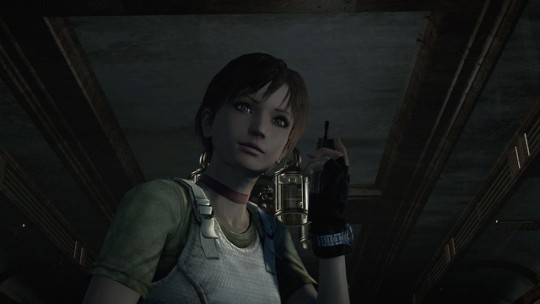



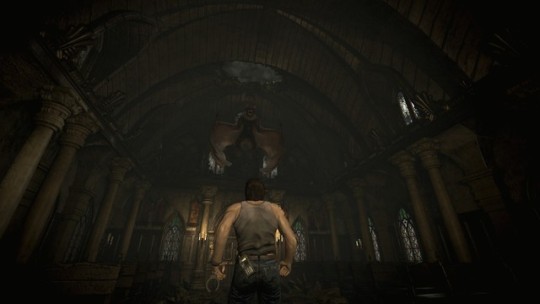
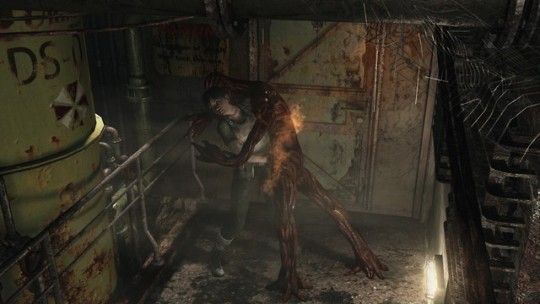

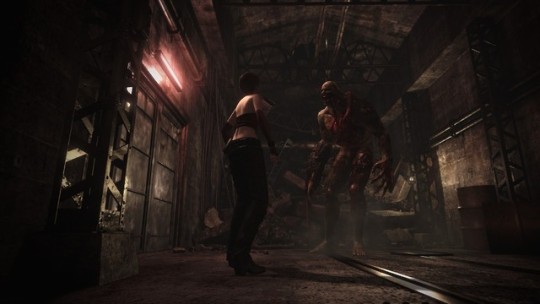

The horrific Resident Evil playthrough, part six
Resident Evil Zero starts with a bang and a wonderfully tight example of level design, as new STARS member and series cutie pie Rebecca Chambers investigates the Ecliptic Express, an Umbrella-operated train that’s become the testing ground for an early version of the zombie virus. On the train, she meets an escaped convict named Billy Coen, and the two of them have to blast their way through tight cars filled with bio-weapons and a great number of leeches, which play an important role in this game, before finding a way to stop their Orient Express outta hell.
I adored RE Zero’s Ecliptic Express, partly because I have a thing for old locomotives and also because it reminded me of 1997 adventure game The Last Express, but with zombies. The environment also felt wonderfully fresh, since aside from the ruined Raccoon City briefly featured in RE 2 and more prominently in RE 3, the majority of the series has, thus far, been content to fall into a fairly standard cycle of settings - mansions, ruined industrial complexes and underground laboratories. What better way to inject some variety into this mix than with a Gothic train, perhaps the perfect environment for a survival horror game thanks to its many rooms, narrow hallways and plentiful hiding spots for the walking dead?
Unfortunately, the Ecliptic Express is more or less the highlight of RE Zero’s environments, and once Rebecca and Billy crash the train and end up in an old Umbrella training facility, the game once again falls back into the trope settings that Capcom was content to recycle. This was a disappointment, but RE Zero injects some unusual, experimental shifts into the gameplay experience that make up for packing its most atmospheric surprises into the first hour, though not all of them are entirely successful.
Chief among these is the partner zapping system, which has players controlling two characters at the same time and occasionally separating them to solve puzzles, like when Rebecca has to stand on an elevator to reach a higher area and Billy has to work the controls. It’s good stuff, since if one thing has become clear to me since beginning this RE journey, it’s that the series has always harbored fantasies of being a partner affair but never was quite able to figure out how to do it. Previous games would only feature very brief sections where another character accompanied you, and the rest of the time, they would keep making ridiculous excuses for why they needed to split up, kinda like members of the Scooby-Doo gang. With Becca & Billy, finally this nonsense has been done away with, and while you now have twice the amount of inventory management to wrangle with, it’s great to finally explore these secluded, dangerous environs with some backup. The fact that Becca & Billy are actually good characters with chemistry helps, and while it’s understated, the story gradually forces them to trust each other more and more. It all stays mutually respectful and there’s no forced romance angle (even though I totally ship these two), but when Billy gets into a bit of a tight spot near the end of the game and Rebecca desperately shouts out his name in panic, you can sense how much she’s bonded with him through their shared night of terror.
I mentioned inventory management, and this leads me to RE Zero’s other big surprise - the magical connected item boxes that have been a series save point trademark are completely AWOL in Zero, and players can actually drop their stuff anywhere, a first in the franchise. Apparently, the devs implemented this to take advantage of the nonexistent load times of the cartridge-based Nintendo 64, which was supposed to be the original platform for this game. (Prototype footage of the N64 version exists and looks impressive, though the ROM’s never been leaked, unfortunately.) I’ve also read that they did it to bump up the difficulty level and intentionally go back to the essence of Sweet Home, the grandpappy of the series.
I thought Sweet Home was a fantastic hidden gem, but the limited inventory space and necessity to drop your items was actually my least favorite part of the gameplay, since it led to lots of housekeeping and backtracking where you’d realize you needed a particular tool but had left it on the ground ten screens away. And this problem exists in RE Zero as well, which is probably one of the lead criticisms that the game faces on the internet. In my opinion, Zero’s backtracking is nowhere near as bad as in Code Veronica, but there were definitely large stretches of the game where I was simply picking up all my crap and moving things to save point rooms, which I basically converted into makeshift item storage halls. There are also a lot of items in the game, like the hookshot, which take up two slots in Becca & Billy’s precious inventory space and aren’t used for a long time only for the game to suddenly drop a “hey you need this to progress” moment, which is liable to piss folks off. I can understand the devs wanting to make things harder, but there’s a fine line between challenge and annoyance, and Zero’s inventory wrangling occasionally enters the realm of the latter. It would’ve been best if the team had given players the ability to drop their stuff and included the traditional item boxes, but unfortunately, it seems like they were operating under the mentality of “we’ll give you ONE freedom but take ANOTHER away, muahaha!”
In the end, I was able to forgive most of the item problems thanks to the fact that I liked Rebecca and Billy so much, and I had more fun with RE Zero than most of the fanbase, which tends to view it unfavorably. If I were to rank all the classic Resident Evils, I’d actually put Zero right under REmake, RE 2 and RE 1, and in my eyes, it’s better than RE 3 and Code Veronica, which end up on the bottom of my list for different reasons. (RE 3 is competent fun but kinda by-the-numbers, and Code Veronica remains the only Resident Evil game which really felt like a slog the more I played of it.)
Why then does Zero end up getting so many apathetic reactions? Well, it’s probably because aside from the inventory management problems, this game feels a little unnecessary, which is an issue that most prequels suffer from. Zero was advertised as revealing the details behind the tragic mission of the Bravo STARS, the team that you learn was slowly massacred over the course of Resident Evil 1. Unfortunately, aside from Rebecca and a few token cameos, the Bravo guys are barely in the game at all, and most of the plot revolves around the background of Umbrella and a case of backstabbing and industrial espionage where one of the original founders, James Marcus, was killed by his colleagues. Marcus, who created the zombie virus via experiments with leech DNA, was resurrected by the very leeches he experimented with, and now he’s out for revenge.
All of this is vaguely interesting, but if I’d been a hardcore RE fan back in the day and was promised a prequel that revealed the fates of the Bravo STARS only to be given a side story about a dude and his leeches, I’d probably go WTF. Capcom dropped the ball on their storytelling by providing something that nobody was really asking for, in other words, and I’ve found out through my meanderings on the Resident Evil Wiki that The Umbrella Chronicles, a spinoff game for the Wii, actually delves deeper into the deaths of Bravo team. That’s the sort of stuff Zero should’ve focused on in order to feel more needed in the grand scope of Resident Evil. Another option might have been to ax the prequel concept entirely, which leads me to another thought that’s only appropriate to bring up now that I’ve finished all of the “old school” Resident Evil games.
If it had been up to me, I probably would have plotted the course of the series differently after RE 2, which contains an interesting nugget of information hinting at an Umbrella Europe base that was never expanded upon to its full potential. The game seems to indicate that Jill, Chris and Barry are going to Europe to investigate and shut down this facility, and just about EVERY strategy guide, article and bit of speculative message board posting I can find from around that time was obsessed with this concept. It seems like everyone thought that Resident Evil 3 was going to be a rollicking European adventure…and it wasn’t, it was instead a game that took place at the same time as RE 2 and explained how Jill escaped Racoon City. Code Veronica never really expounded upon this tidbit of lore either - we get a very brief intro with Claire Redfield investigating an Umbrella headquarters in Paris, but then suddenly she’s captured and the vast majority of that game takes place on an island near South America.
I can’t help but feel like a massive opportunity was missed here, and if I’d been in charge of Capcom’s scenario division for these games in the late 90s, I would’ve changed the plot of Code Veronica and basically made that one Resident Evil 3 (which it was originally going to be if Capcom hadn’t wanted to keep the “main” RE games on a Sony console). I would’ve made it an adventure with Jill, Chris and Barry in Europe, and near the end I would’ve brought Claire in to join them and fight alongside her brother. Then, I would’ve made a spinoff game simply titled “Resident Evil: Nemesis” or something of the sort, and taken the general “escape Racoon City” plot of RE 3…but had it star Rebecca Chambers.
See how nicely that would’ve worked? Fans would’ve gotten their detailed peek at Umbrella Europe and the return of the classic combo of Jill + Chris + Barry. The weird Ashford siblings and Code Veronica doofus Steve could’ve still been incorporated into the story. Meanwhile, Rebecca could’ve starred in a game that felt necessary, since the beginning scenes of destroyed Racoon City were some of the best bits of RE 2, and there’s no reason why she couldn’t have met escaped convict Billy Coen while escaping the city. They could’ve worked together to flee from Nemesis, and I guess the mostly forgettable mercenaries of RE 3 could’ve made an appearance as well.
Sadly, I don’t work at Capcom, and they planned these games totally differently. We finally would go to Europe proper with Leon Kennedy in the next RE game, but that one would mark a shift in both storytelling and atmosphere, as Resident Evil quickly transitioned away from its horror roots…and into the realm of fast-paced shoot ‘em up action.
Resident Evil 4 is next, and the playthrough continues!
All screenshots taken by me. For more, check out this Twitter thread showing my step-by-step progress through the game.
#pixel grotto#video games#now playing#resident evil#biohazard#resident evil zero#rebecca chambers#billy coen#capcom
7 notes
·
View notes
Text
Living in the Illusion: Queer expression and relationships between fiction and physical spaces and representation
My portfolio (and effective final) for HUM4938: Media, Power, and Sexuality. In abstraction, an analysis of the role of media in portrayal and/or realization of queer characters and spaces, and its relation to the constructed fictionalization/stigmatization of queer people in real life.
Introduction
On June 24th, I landed in London. It was my first time outside of the United States, and an opportunity to study and learn a new city, a new culture outside of my own, and of course, explore my own relationship to that. But I was a student, first and foremost. I spend my week studying, going from class to class, to excursions and museums and parts of town I couldn’t even dream of finding on my own. As the days went on, so more did I see new prismic projections down the streets and up the escalators of the underground, peering through at tube stations and in coffee shops and in the alleys of Leicester square. The west end soon became a flurry of rainbows—the city, although already diverse and buzzing, was more and more colourful as it anticipated the arrival of the celebration of freedom of expression of love.
Although I’d been somewhat involved in LGBTQ+ groups and discourse in my time in high school, and certainly had gone through moments of questioning my personal identity, I’d never been to a Pride parade, or any queer community event for that matter, before. I wasn’t sure if I was meant to go; at the time, and still currently, I identify somewhere between asexual and bisexual—a demi-bisexual. Since there’s some ambiguity among the members of the LGBTQ+ community about ace and bi individuals as to where they belong in representation, activism, and portrayal, it seemed a little difficult to throw myself in the mix. In any case, my preferences have never been evocative of any particular direction or affect, and I’d been hesitant to label myself, either in fear of being wrong, or perhaps in fear of being misunderstood, judged. Quite simply, I was never really sure if I was really queer enough, so I never came out.
And so, out of pure curiosity, and perhaps with a little sense of hopeful belonging, I went the second Saturday of my trip to London Pride—it was a special event, as it was the fiftieth anniversary of the partial decriminalization of Homosexuality: a civil rights benchmark that was so significant to the progress and acceptance of so many individuals in modern society. It was a colourful event, filled to the brim with unbelievable spectacles of love, joy, happiness, exuberance, glitter, rainbows, and what seemed to be absolute magic performed by drag queens and shown by endless seas of flowing rainbow-coloured fabric, flags flying down Oxford street, highlighted by a rugby player’s proposal to his boyfriend, furthered by the unending positivity between all those who attended. I felt an innate sense of grounding in camaraderie with the people surrounding me, in the crowd and on the parade route, that I never felt before, regarding sexuality and identity, really.
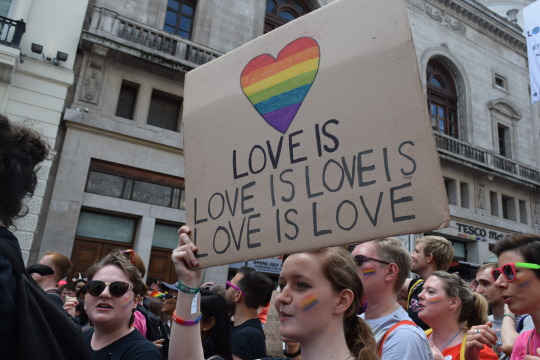
But it so too felt almost unreal—not only in the way that I was four thousand some miles away from home, but too because my understanding of LGBTQ+ history was that of struggle; up to this day. The presence of protest groups in the pride parade made a stark contrast to the parties surrounding—while the parade remained a spectacle, and celebration of what had been achieved, groups like stonewall and others were reminiscent of the original intent of pride; to make it clear that queer individuals existed, and should be treated as any other human being, through breaking that spectacle, and agitating others as to make sure they are heard, and change takes place (as Oscar Wilde noted, “That is why agitators are so absolutely necessary,”). The perfect, rainbow-coloured parade was manufactured by the many corporations that sponsored the event, and that “pink-washed” (and furthermore was a part of the depoliticisation of) what was once a political protest and communal event for demanding solidarity and equal representation. It was dismal to think, even at the back of my mind, that something so beautiful was at its foundation, (like many things) corrupt.
The day after pride, our class took an excursion to the new music biannual conference—or festival, I’m not too sure—it was the final performance of the series, a piece composed by avant-garde contemporary composer Philip Venables, featuring the London Sinfonietta and queer performance artist David Hoyle: Illusions (read more about this excursion here). It wasn’t exactly a speech pattern composition, but an orchestral interaction between parts of the text that elicited rhythm and meaning.
youtube
Although it is the title statement, one phrase did manage to stick out to me, after pride, and even continuing into further exploration of queer culture in London—Hoyle mentions of democracy in the current age (2015 was the original release of the piece, but Venables, in an interview between the performances, still noted its relevance two years later) “you know and I know it’s an illusion,”. The piece was addressed mostly to the new conservative government—but too was shown to those in attendance, ranging from any given socioeconomic class (but most likely, those who could afford a ticket were of middle or higher status) and sexuality or gender identity. So, which population experiences that illusion? Perhaps it is all those there at the moment.
This idea (moreso a conundrum) remained in my mind until now—and I thought I should explore the idea of illusion when it comes to the portrayal and understanding, as well as the identification of homosexuality and queerness in media.
Illusion (n.) - 1. a misleading image presented to the eye 2. the state or fact of being led to accept as true something unreal or imagined 3. a mistaken idea
The Illusion
So often queerness is treated as if it is illegitimate; perverse; a figment or fancy of the imagination. Homosexuality, although partially decriminalised in England and Wales in 1967 under the Sexual Offences Act, was only decategorized from major psychological association’s published texts as a mental disorder in the 1970’s—trans* folk were even more outspoken in the medical community, with gender identity disorder only leaving the volumes of the DSM-V in 2012. Being queer was to be mentally ill, and was to live in illusion, to the understanding of society.
But who truly lived in that illusion? To queer folk, their experiences were all but as real as any other. The fictionalisation, or rather, assignment to obscurity of homosexuality and queerness too fictionalised those individuals accounts and agency when it came to social action: it was (and still, to a certain extent is) harder for LGBTQ+ individuals to assert certain self-evident rights in many situations. That fictionalisation too worked against them, when they were victims of continued cultural persecution, legal prosecution, and violence from various outlets. The stigmatisation of the community and of homosexuals in media, and the cultural paradigm that had existed prior to legal decriminalisation created a heavy ideal that, still today, continues to threaten even the basic levels of hierarchical need of queer individuals, forcing them to live “in the closet”, diminishing personal mental health and relationships, fostering subversive and possibly dangerous ways of life (queer individuals more prone to homelessness, drug use, contracting STIs, prone to domestic and direct violence), taking away access, or not deeming necessary, social resources, all caused by accepting queerness as fictional, and denying the existence of quite a large portion of the population, dismissing them as unreal.
It’s no wonder, then, that queer individuals have become so accustomed to their lives being called fiction—as they have produced some of the most intricately creative pieces of artwork, literature, and music, that exist in the realm on the edge of stark, political, reality and sensual, blissful, scary, manic dream matter.
The Theatre
There is no secrecy in that the Theatre is a queer space. Not really that all people who work and live in the theatre scene are gay (as somehow, that’s become another stereotype in this weird world of ours)—but its one of the safest spaces for creatives who have different identities, historically. Among those dancers, writers, actors, and more, Vaslav Nijinsky (as discussed in the V&A Tour, post coming soon), Stephen Sondheim, on and on and on, furthermore, the material that comes out of the theatre is usually intersectional in its inclusion of different demographics, from race to identity to sexuality, and there are so many queer cult classics from the theatre world: RENT, Fun Home, Belle Reprieve, etc. etc. etc. If I had to list all of the queer creators and significant creations in the performance world, I would probably not be able to write this piece.
The Theatre is also a place where illusion itself lives. The entire concept of the theatre is a space in which one experiences a suspense of disbelief: a temporary adoption of ideas or mindsets, settings and events that aren’t necessarily true. Whether through costume, set design, make up, technical design and lighting or the sheer action and verbiage of the script, plays, musicals, reveries, cabarets, and skits involve the audience and actors in a whole mirage of make-believe. This is important.
In London especially, theatre has played an active role in queer representation and activism, if not simply by being the space for those individuals, then by creating attention. Both Stuart Feather and Jill Dolan remark in their books about the involvement of Street Theatre in the movement for decriminalisation of homosexuality, and collaboration with the Gay Liberation Front in the 1970’s. The culture surrounding the theatre here, in the west end, as well as on Broadway, is one of avid acceptance of queer art.
A indication of that culture was alive and well in the Cafe de Paris—a nightclub and performance venue in Leicester Square, which our class visited later in the week. The performance that night was the Seven Sins Cabaret—a cabaret, of course, reminiscent of the red-light district, raunchy, and alcoholic gatherings of parisian businessmen in underground bars and performance venues, and the later production between Bob Fosse and Fred Ebb, which focused on sexuality and subversive performance culture in Nazi Berlin in the Kit Kat Klub. It certainly surpassed expectations (link to post coming soon) and was a pinnacle of scintillating, slightly erotic? but completely empowered performance. Upon posting to instagram, the emcee and director of the show, drag performer Reuben “Ruby” Kaye, commented on my post, still just as enthusiastic about the openness and the stark portrayal of sexuality, and the intimacy of performance and the way it helps shape ideas and removes hurtful stigma about open sexuality.
Later, I also had the opportunity (on the last night, no less--link to post coming soon) to go to the west end and see Kinky Boots at the Adelphi Theatre. I’d never seen the musical before, but I knew it was one of the quintessential pieces from the United Kingdom that deserved a look—as well as a significant LGBTQ+ representative production, as it focused on the friendship between the protagonist, Charlie, and his opposite story centre, Lola, a drag queen who helps Charlie navigate a difficult time in his life, dealing with the death of his father, and learning how to define himself as a man, as the Mr. Price of his family business Price and Sons.
Its an incredibly liberating and relatable piece—perhaps people don’t come to the theatre to see Kinky Boots if they aren’t open-minded already, but certainly, the older ladies in the row in front of me had a wild time at the show. The most impressive pieces to me, regarding identity and sexuality, are that of Lola’s pieces—first, “Lola’s World”, in which the lyrics read “Step into a dream, Where glamour is extreme, Welcome to my fantasy,” followed by the number “What a Man” in which the roles of gender are explored and reversed, and used to empower the performer. Of course, “Just Be”, too is a fantastic pride anthem, preaching for unlimited self expression. In the show, Lola is completely open about who they are and what they are, and what it means to be them, completely breaking any sense of deceit or illusion that goes along with being a performer, a person with two identities at face value.
A Stand Out: Todrick Hall
Aside from starring as Lola in the fall/winter 2016 season on Broadway, this openly gay creator has recently risen to a relatively popular stance in the performance world—both on stage (in Oz, Kinky Boots) and in television (as a recent host and choreographer on RuPaul’s Drag Race, the creator of Todrick MTV, and contestant on American Idol) by way of his YouTube channel, which he started in 2006. A decade later, Todrick has amassed over 2.5 million subscribers.
I found inspiration for this analysis in watching some of his videos, which feature his takes on pop culture classics, like Mean Girls, Disney films such as Alice in Wonderland, Beauty and the Beast, and plays (namely Chicago, as there are several cell block tangoes) and reimagines them as hollywood, gay, and black versions of the predominantly white, straight originals.
One that stood out especially, perhaps because of its magnitude as a project (it’s a feature-length video on his YouTube), is an autobiographical musical re-adaptation of the Wizard of Oz called Straight Outta Oz—the story closely following the narrative of the original, but in this version, Todrick is Dorothy, and his story is a reflection of growing up gay, growing up black, and navigating a technicolor world. These themes are directly related to the course’s parameters: it is media, and the power involved, and how sexuality comes into play.
youtube
(If you have the opportunity, skip to ‘Water Guns’ near the end of the video)
Following what Ruby Kaye imparted in her comment on my instagram post of “Perform, Educate, Empower,” Todrick fully explores what it means to be the content creator, producer, director, and performer of queer art and media made for the masses. His art takes the illusion, whether it be from the suspense of disbelief in the theatre, the makeup of drag queens, the use of music, or simply, the line between what is fictional in literature and real life, and applies it to a wholly human and enthralling experience, not necessarily to enlighten, but to ground—to create a common space that feels safe, welcoming, and intriguing, if anything. The fictionalisation which was used against him and other queer individuals is reclaimed in fantasy.
Creators like Todrick, who are now more able to express themselves in openly queer artistic choices, are not only the future of artistic production, but are also leading the way for progress in the destigmatisation of queer identity, diminishing the illusions of obscure gender and sexuality and making them known.
Conclusion
In 2016, the shooting at the PULSE gay nightclub in Orlando, Florida, was exactly that: a display to make us realise that we were not safe. That to a certain extent, the LGBTQ+ community (especially the L, G, B) did live in an illusion of security. That we were still so far from acceptance. It only took so much hate (that had already existed, so evidently, yet that was shrouded by progress, by the spectacle of parade and celebration) to take away the lives of so many.
The line between what is real and what is illusory has always existed for the LGBTQ+ community. But for queer individuals, the distinction of either is all too clear. They are not the ones living in an illusion, but rather the ones working to shatter it.
References & Further Reading
Venables, P. (Composer), Hoyle, D. & London Sinfonietta, (Performers), Baker, R. (Conductor). (2017, July 9). Illusions. Live performance at Southbank Centre, London, United Kingdom.
Venables, P. (2015, September 19). Illusions. Retrieved July 2017, from https://www.youtube.com/watch?v=g4hJQimj45U
Ackroyd, P. (2015). Queer City: Gay London from the Romans to the Present Day. London: Chatto & Windus.
Dolan, J. (2010). Theatre & sexuality. Basingstoke: Palgrave Macmillan.
Feather, S. (2016). Blowing the Lid: Gay Liberation, Sexual Revolution, and Radical Queens. Alresford: John Hunt.
Fierstein, H., & Lauper, C. (Writers), Mitchell, J. (Director), & Oremus, S. (Conductor). (2017, July 21). Kinky Boots. Live performance in Adelphi Theatre, London.
“Illusion”. 2017. In Merriam-Webster.com. Retrieved from https://www.merriam-webster.com/dictionary/illusion
Playful Productions. (2017). Kinky Boots [Brochure]. London.
Kaye, R. (Director). (2017, July 14). Seven Sins Cabaret. Live performance in Café de Paris, London.
Milazzo, F. (2016, September 12). Review: Seven Sins, Cafe de Paris. Retrieved from http://www.thisiscabaret.com/review-seven-sins-cafe-de-paris/
To contribute further to my research, if you are queer or identify in a way that you find different to cis- and hetero-normative tradition, consider completing this survey about your experience regarding the relationship between fiction, illusion, and queerness. Please follow, and if you’re keen on contributing, citing, or collaborating further to this research, send me an ask or submit!
1 note
·
View note